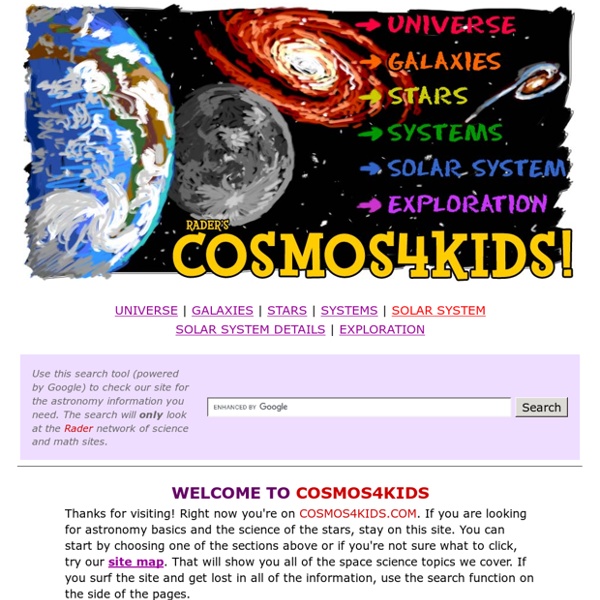



StarChild: A Learning Center for Young Astronomers The StarChild site is a service of the High Energy Astrophysics Science Archive Research Center (HEASARC), Dr. Alan Smale (Director), within the Astrophysics Science Division (ASD) at NASA/GSFC. StarChild Authors: The StarChild Team StarChild Graphics & Music: Acknowledgments StarChild Project Leader: Dr. Laura A. Whitlock Curator: Responsible NASA Official: If you have comments or questions about the StarChild site, please send them to us. NASA Kids Club Skip to main content NASA Kids Club › Text Only Site Space Racers HippoCampus - Homework and Study Help - Free help with your algebra, biology, environmental science, American government, US history, physics and religion homework
Online Star Register - Astronomy Basics & Links Astronomers study our universe and the objects found within it such as stars, planets, and galaxies like the one we live in, the Milky Way. Almost one quarter of all astronomers are women and almost all professional astronomers work in the field of government or education. Despite popular belief, astronomers spend more time in the classroom and on the computer than staring through a big telescope pondering the stars. Amateur astronomers, also called “backyard” astronomers, spend more time stargazing. It’s important to remember that without the constant watch from amateur astronomers, many stars and comets would not have been found. Amateur astronomers are very important to the field of astronomy.
Sea and Sky - Explore the Oceans Below and the Universe Above Kaizena · Give Great Feedback Tres, dos, uno, cero… ¡despegue! ¿En qué consiste la aplicación y cómo usarla?La aplicación Solar System Scope, disponible en es una simulación en 3D que recrea el Sistema Solar. Desde diferentes modos de visualización, heliocéntrico, geocéntrico y panorámico, podemos recorrer los planetas a la vez que observar sus movimientos, conocer la ubicación de las estrellas hasta ahora nombradas, calcular distancias y observar la relación entre los cambios del calendario, el reloj y los movimientos del sol. Planets For Kids - Solar System Facts and Astronomy Brainstorming and Voting Amazingly Easy. Free Online Tool dudtbunny's Astronomy for Kids! The Triffid Nebula The Triffid Nebula got its name because it resembles a fungus found here on EarthImage Courtesy of:Hubble Space Telescope If this is your first time here, you may want to visit the Site Information section first. If you are looking for something in particular, you will probably be able to find it either in our Site Index or the Site Map. At the same time, some of life's most fascinating journeys are the ones we don't plan. Astronomy For Kids is back!
The Solar System Our solar neighborhood is an exciting place. The Solar System is full of planets, moons, asteroids, comets, minor planets, and many other exciting objects. Learn about Io, the explosive moon that orbits the planet Jupiter, or explore the gigantic canyons and deserts on Mars. Sun, Moon and Earth Orbits Learn about our planet, our only natural satellite and our nearest star © 2012 This website is produced by the Student Recruitment, Admissions and International Development Division at The University of Manchester